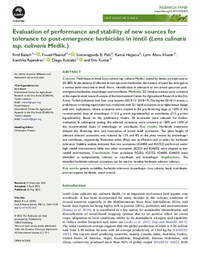Evaluation of performance and stability of new sources for tolerance to post-emergence herbicides in lentil (Lens culinaris ssp. culinaris Medik.)

Authors:
Yield losses in lentil (Lens culinaris ssp. culinaris Medik.) caused by weeds are estimated at 20–80%. In the absence of effective broad-spectrum herbicides, the menace of weed has emerged as a serious yield constraint in lentil. Aims. Identification of tolerance to two broad-spectrum post emergence herbicides, imazethapyr and metribuzin. Methods. 221 lentil accessions were screened at the experimentalresearch station of the International Centerfor Agricultural Research in the Dry Areas, Terbol (Lebanon) over four crop seasons (2014/15–2018/19). During the 2014/15 season, a preliminary screening experiment was conducted with 221 lentil accessions in an alpha lattice design with two replications, where accessions were treated at the pre-flowering stage at 150% of the recommended dose of imazethapyr (112.5 g active ingredient/ha) or metribuzin (315 g active ingredient/ha). Based on the preliminary results, 38 accessions were selected for further evaluation. In subsequent testing, the selected accessions were screened at 100% and 150% of the recommended doses of imazethapyr or metribuzin. Key results. Herbicide treatments delayed the flowering time and maturation of tested lentil accessions. The plant height of selected tolerant accessions was reduced by 15% and 8% in the plots treated by imazethapyr and metribuzin, respectively. Reduction index (RIsy) was an effective tool to select for herbicide tolerance. Stability analysis indicated that two accessions (IG4400 and IG5722) performed under high rainfall environments while two other accessions (IG323 and IG4605) were adapted to low rainfall environments. Conclusions. Four accessions (IG323, IG5722, IG4400, IG4605) were identified as independently tolerant to metribuzin and imazethapyr. Implications. The identified herbicide-tolerant accessions can be used to develop herbicide-tolerant cultivars.
